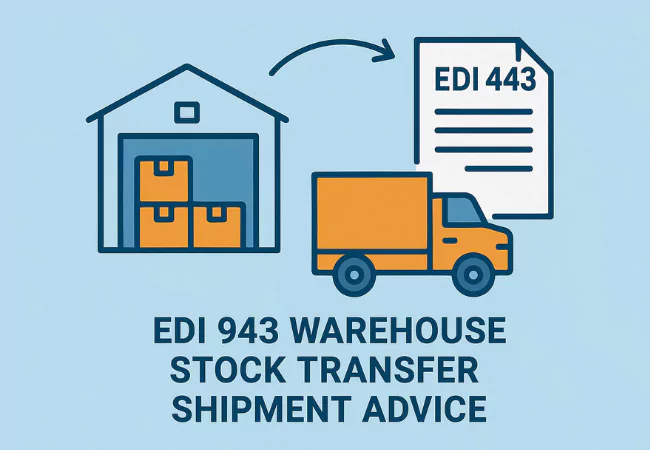EDI 943 is an electronic document used to communicate shipment details from suppliers to remote warehouses. It facilitates accurate stock transfers and enhances inventory management. This article breaks down its key components, benefits, and practical applications.
Key Takeaways
- EDI 943 is a specialized document for electronic shipment communication between suppliers and warehouses, ensuring accurate and timely transfer of shipment details.
- Key components of EDI 943 include transaction headers, warehouse information, and item identification, all crucial for effective inventory management and reducing discrepancies.
- Implementing EDI 943 streamlines operations by minimizing errors, lowering labor costs, and enhancing visibility in inventory management, while also following strict ANSI and ASC X12 standards.
What is EDI 943?
The EDI 943 is a specialized document used for electronic data interchange communications with remote warehouses. It serves the crucial function of transmitting detailed shipment information from higher-volume suppliers and manufacturers to third-party logistics companies or third-party warehouse locations.
This document includes comprehensive details such as shipment date, item specifics, and carrier details, which are essential for the receiving warehouse to prepare for incoming stock. EDI 943 ensures that all parties involved in the shipment process receive accurate and timely information, reducing the risk of errors and inefficiencies.
Key Components of EDI 943
Understanding the power of EDI 943 involves breaking down its key components. This transaction set includes elements like headers, item identification, and shipment details, each playing a vital role in facilitating warehouse stock transfers.
Each of these components contributes to the overall efficiency of the EDI 943 document.
Transaction Headers
Transaction headers in an EDI 943 document form the backbone of the communication process. These headers contain general information like the transaction set identifier code and control number, providing a unique identification for the transaction. This allows both the sender and receiver to track and reference the transaction accurately.
Headers include fundamental details like the transaction date and context, which set the stage for the information that follows. Clearly defined transactions streamline the process, ensuring all parties are on the same page.
Warehouse Information
Warehouse information is another critical component of the EDI 943 document, including essential details like shipment dates, manufacturer information, receiving warehouse identification, and carrier specifics. These details are vital for effective communication between suppliers and warehouses, ensuring that each shipment is accurately tracked and managed.
Identifying both the sending and receiving location warehouses helps maintain accurate inventory records and facilitates smooth operations within the supply chain.
Item Identification and Shipment Details
Item identification in the EDI 943 document is crucial for accurate tracking and handling of shipments. Each item is identified by unique product codes like SKU or UPC, along with details such as quantities, weights, and descriptions. This meticulous accounting ensures every item in the shipment is tracked.
Detailed information in this section, including total quantity and unit of measure, significantly aids in inventory management. It helps the receiving warehouse prepare for incoming shipments and verify the accuracy of received items against the EDI 943 document.
Transaction headers also provide general details about the shipment, such as the shipment date and sender identification. This comprehensive approach ensures all parties have a clear understanding of the shipment details and the transfer shipment, reducing the risk of discrepancies and miscommunications.
How EDI 943 Facilitates Inventory Management
EDI 943 plays a pivotal role in enhancing inventory management by enabling real-time communication between trading partners. This real-time exchange of information helps reduce inventory discrepancies and ensures that all parties have the most up-to-date inventory records.
The automation of EDI 943 documents minimizes the likelihood of human errors in stock transfer information, thereby boosting operational efficiency. As an advance ship notice specifically designed for remote warehouses, the EDI 943 includes unique identifiers for both sending and receiving locations, shipment dates, delivery estimates, and warehouse stock transfer shipment identification.
Generating an EDI 943 document with all necessary details about items, quantities, and shipping information allows warehouses to effectively prepare for incoming shipments. This streamlined process reduces paperwork, cuts down labor and material costs, and enhances transparency within the supply chain.
Practical Applications of EDI 943
The practical applications of EDI 943 extend beyond just stock transfers. For instance, manufacturers can use EDI 943 to authorize returns accepted by the warehouse, making it a versatile tool in inventory management. Unlike EDI 856, which is directed towards customers, EDI 943 is uniquely designed for communication with remote warehouses.
Upon receiving an EDI 943, the corresponding warehouse typically responds with an EDI 997 Functional Acknowledgement to confirm receipt. This electronic nature of EDI 943 allows for easier tracking of shipment history and discrepancies, thereby strengthening the relationship between suppliers and warehouses through consistent and accurate messaging.
EDI 943 Format and Specifications
The EDI 943 format adheres to stringent standards set by the American National Standards Institute (ANSI) and ASC X12, ensuring a consistent structure for data exchange. This adherence to standards includes detailed segment definitions, data element definitions, and syntax rules that are critical for creating valid documents.
The secure transmission of EDI 943 is achieved through methods like AS2 or FTP between the sending and receiving warehouses. These secure transmission methods ensure that the sensitive information contained within the EDI 943 document is protected during the exchange process.
Benefits of Implementing EDI 943
EDI 943 offers several benefits, including enhanced visibility and accuracy in inventory management. Both senders and receivers can promptly update their inventory systems after stock transfers, ensuring that inventory records are always up-to-date. This capability reduces the chances of stockouts or overstock situations.
Moreover, the implementation of EDI 943 can significantly reduce labor costs associated with manual data entry and document handling. Moreover, EDI 943 reduces paper consumption by eliminating the need for paper-based documents, offering a positive environmental impact.
Common Challenges and Solutions with EDI 943
Deploying EDI 943 can come with its own set of challenges, such as ensuring systems compatibility. This complexity can be resolved by choosing a full-service EDI provider to manage technical integrations, ensuring a smooth implementation process.
Managing ongoing EDI transactions can also overwhelm businesses. Utilizing a comprehensive EDI solution can ease this burden by handling connectivity and compliance concerns, making the entire process more manageable and efficient.
Difference Between EDI 943 and EDI 944
The primary difference between EDI 943 and EDI 944 lies in their timing and purpose. EDI 943 acts as a notification about an upcoming shipment, while EDI 944 serves to confirm the receipt of that shipment once it arrives. This distinction is crucial for maintaining accurate records and ensuring that all parties are informed at each stage of the shipment process.
Once an incoming shipment is received as per the EDI 943, a corresponding EDI 944 transaction is sent back to confirm receipt and provide details of the shipment, including any discrepancies.
Automating EDI 943 Transactions
Automating stock transfer notifications through EDI 943 leads to a decrease in paperwork and accelerates order processing, enhancing operational efficiency. This automation reduces the need for manual intervention, thereby minimizing data entry errors and enhancing accuracy during shipment reconciliation.
The creation of a virtual documentation trail through EDI 943 automation is valuable for resolving discrepancies with receiving warehouses. Additionally, the transactions are secured through encryption and protocols, ensuring data protection during transmission.
Summary
In summary, EDI 943 is an indispensable tool for managing warehouse stock transfers efficiently. By providing detailed shipment information and facilitating real-time communication between trading partners, it enhances inventory management and operational efficiency. The benefits of implementing EDI 943, such as reduced labor costs and positive environmental impact, further underscore its value.
As businesses continue to seek ways to streamline their operations and improve accuracy, EDI 943 stands out as a robust solution. By embracing this technology, companies can ensure that their supply chain processes are not only efficient but also resilient and adaptable to future challenges.
Frequently Asked Questions
What is the primary purpose of EDI 943?
The primary purpose of EDI 943 is to facilitate detailed shipment information communication between suppliers and remote warehouses, promoting accurate and efficient stock transfers. This enhances supply chain operations significantly.
How does EDI 943 enhance inventory management?
EDI 943 significantly improves inventory management by facilitating real-time communication and minimizing discrepancies, while also delivering comprehensive shipment details that help warehouses efficiently prepare for incoming stock.
What are the key components of an EDI 943 document?
The key components of an EDI 943 document are the transaction headers, warehouse information, and item identification along with shipment details. Ensuring these elements are accurately included is vital for effective communication in logistics.
How does EDI 943 differ from EDI 944?
EDI 943 serves as a notification for an upcoming shipment, whereas EDI 944 confirms receipt of that shipment, facilitating accurate records and communication throughout the logistics process.
What are the benefits of automating EDI 943 transactions?
Automating EDI 943 transactions significantly boosts operational efficiency by reducing paperwork and minimizing data entry errors. Additionally, it enhances data protection through encryption and secure protocols, ensuring your transactions are safe and reliable.




